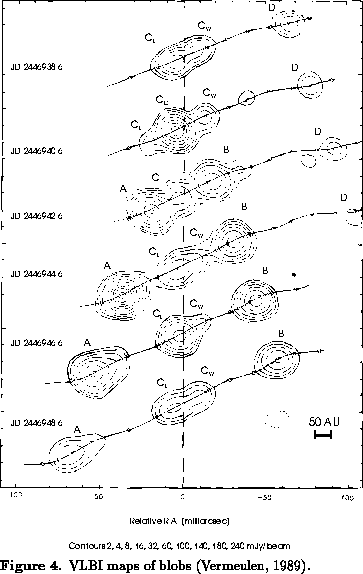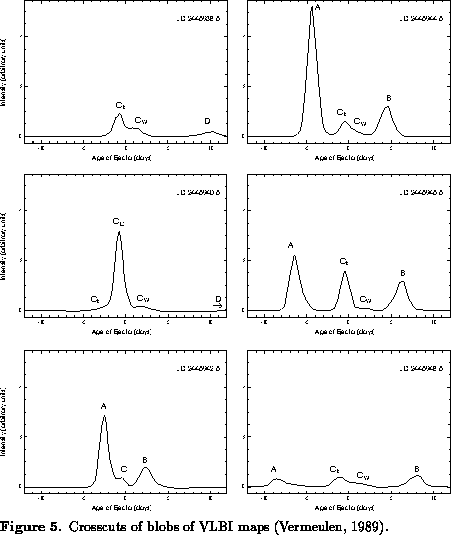
During the second observing campaign of Vermeulen et al. (1989) SS433 changed from its quiescent mode to the flaring state. A total of five flaring events were observed. Data were taken at nine different frequencies ranging from 408 to 8085 MHz plus additional measurements at seven intermediate and higher frequencies up to 22.5 GHz. Daily spectra were taken although not all frequencies were used every day. In order to determine the peaks in flux density and the time when these peaks in flux density were reached interpolation between the measured data was nessesary. Vermeulen et al. (1989) make the assumption that the spectrum of SS433 can be described as the superposition of a constant quiescent background and a number of independent flares, each with its own evolving spectrum.
Just before a flaring state a small dip in the flux density is seen at many frequencies. This dip may be related to the ejection, at the start of the flaring, of some matter which is initially optically thick at radio wavelengths. When the object starts to flare it then becomes optically thin. This matter would have to create a region of obscuration, blocking emission from behind it, as seen from the observer (Vermeulen et al. (1989)). It is also possible that the dip is caused by opically thick matter ejected as a shell close to the binary system, and blocking quiescent radio emission from that system. Furter observations of these dips are needed to find out what the exact nature of these pre-flare spectral features are.

The flares have a typical lifetime of five days. They are not very frequency dependent, although they have a tendency to last longer at lower frequencies. Two different kind of flares can be observed. They evolve differently, so it is likely that they originate at different locations in the system. VLBI observations of Vermeulen (1989) show that one event coincides with a brightening of the core component of SS433, and later flares originate in the beams of the object, at some distance away from the centre. Maps from Vermeulen (1989) show that these events are related. The first flare was a precursor of the second one.

Both type of flares cannot be described by just one instantaneous ejection of relativistic electrons followed by an adiabatic expansion. If adiabatic expansion was the only mechanism involved then the peak flux density should drop off rapidly at lower frequencies. The spectra of SS433 show very little decrease. Some flaring events even show an increase in peak flux density at lower frequencies. This excess emission supports the conclusion of Vermeulen (1989) that sustained generation of relativistic electrons is taking place at SS433.